|
 |
|
|
|
|
|
|
|
|
|
|
|
|
|
|
|
|
|
 |
|
| Towns & Cities |
|
| Places to Visit |
|
 |
|
|
|
| Exploring Monuments of Delhi |
|
|
| About Delhi |
|
|
 |
|
| Travel Destinations Guide |
|
|
| Adventure Tours India |
|
|
|
|
 |
Biking Tours |
 |
Paragliding |
 |
Skiing |
 |
Safari Tours |
 |
Water Rafting |
 |
Trekking Tours |
 |
Camel Safari |
|
|
| |
|
|
|
|
|
|
|
|
|
| Temples of Delhi |
|
|
 |
|
| Historical Forts of Delhi |
|
| |
| |
|
|
| Uttar-Pradesh - The Throne of Nawabs |
|
| Back |
 Towns & Cities Towns & Cities
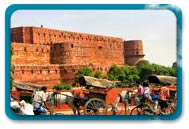 Agra - The Taj Mahal provides solace to the heart and soul of the beholder. It is a great symbol of love that a man has ever built for a woman, which is found in the center of Agra. The whole structure of the Taj Mahal comprises of an intimidating gate, a royal inn and a mosque. This marble mausoleum that was built centuries ago still holds its spellbinding grandeur till date. Agra - The Taj Mahal provides solace to the heart and soul of the beholder. It is a great symbol of love that a man has ever built for a woman, which is found in the center of Agra. The whole structure of the Taj Mahal comprises of an intimidating gate, a royal inn and a mosque. This marble mausoleum that was built centuries ago still holds its spellbinding grandeur till date.
Another magnificent construction of the city of Agra is the Agra fort. In this fort are some of the most beautiful buildings India has ever seen like Divan-e-Aam, Divan-e-Khas and Shish Mahal. The lofty battlements of the fort overlook the mansions of nobles and princes found on the riverfront. There is also a dominating gateway that surrounds the magnificent ramparts, bastions and towers. The Itmad-ud-daula tomb which is found on the banks of Yamuna is worth a visit when in Agra as this is the first tomb to be completely carved out of marble.
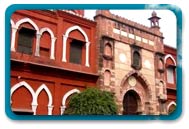 Aligarh - Aligarh is a city of Uttar Pradesh that has both educational and commercial value. Its value started with the founding of Mohammedan Anglo Oriental College in 1875 by Sir Syed Ahmed Khan and grew into the launch pad of nationalist movements in India. Aligarh - Aligarh is a city of Uttar Pradesh that has both educational and commercial value. Its value started with the founding of Mohammedan Anglo Oriental College in 1875 by Sir Syed Ahmed Khan and grew into the launch pad of nationalist movements in India.
With this college, a new breed of educated Muslims was produced who had notable parts in the functioning of the government and its authorities. The college was built with the intention of building a college following British education system, with no compromise on Islamic values.
He maintained that there was no need to be proficient in English and 'Western Sciences' to reach terms of the changing reality. He wanted Muslims to gain modern education and get involved in public life. Raja Jai Kishan helped him in this venture so that Muslims could replace Persians in Government employment and languages of Courts of Law.
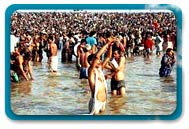 Allahabad- A city whose history dates back to ages immemorial, the entirety of the city of Allahabad has shaped India's heritage as well as her culture in a way that can never be ignored. Almost the entirety of the city is laden with artifacts, most of which add a special touch to the powerful role that Allahabad plays on India and her people. Arguable one of the most favorite cities in the province, Tours to Allahabad are considered to be definite must haves for tourists planning a Tour to Uttar Pradesh.
One of the largest cities in India, Allahabad has a history which dates back to the Vedas. It is believed that the city was blessed by Brahma, Himself, when He performed His first sacrifice in the premises of the city after laying the foundation of the earth. Allahabad- A city whose history dates back to ages immemorial, the entirety of the city of Allahabad has shaped India's heritage as well as her culture in a way that can never be ignored. Almost the entirety of the city is laden with artifacts, most of which add a special touch to the powerful role that Allahabad plays on India and her people. Arguable one of the most favorite cities in the province, Tours to Allahabad are considered to be definite must haves for tourists planning a Tour to Uttar Pradesh.
One of the largest cities in India, Allahabad has a history which dates back to the Vedas. It is believed that the city was blessed by Brahma, Himself, when He performed His first sacrifice in the premises of the city after laying the foundation of the earth.
Bareilly - The Bareilly city, located on the banks of the Ramganga River, is situated within the administrative district of Bareilly. The cosmopolitan township of Bareilly dates back to approximately 500 years ago and was known as Bans-Bareilly, known after the two sons of the ruler Bansal Dev and Baral Dev.Originally, Bareilly was famous for its artistic artwork with bamboo, and the exquisite folk art of embroidery known as Zari-Zardozi. Zari-Zardozi is a traditional type of artwork that utilizes various kinds of gold threading, beads, spangles, seed pearls, gota and wiring for decorating fine furnishings and garments.Bareilly is in close proximity for visiting Delhi and Lucknow hence short trips can be arranged. With seven different rivers flowing through the city, numerous water- related activities can be enjoyed such as swimming, rafting and boating. Bareilly is known for its prominent medical collages, especially the dental and an Ayurvedic college. Even though modern developments are on the rise, Bareilly still retains it small town culture, peaceful atmosphere, rolling green farmlands just on the outskirts of the city. With an increase of tourist visiting here, numerous budget and luxury accommodations are available, making the stay, pleasant and enjoyable.
Firozabad - Firozabad situated in western Uttar Pradesh is a famous commercial center. Situated 200 Kilometers from Delhi, Firozabad is famous through out the world for its glass works. The economy of this city is altogether based around manufacturing bangles and other glass products. Firozabad is the premiere center of glassware manufacturing in India. Although this town produces a large variety and range of glassware in India, it has become synonymous to Bangles. They come in thousands of designs, patterns and colors and are universally liked.
Ghaziabad- Ghaziabad is city rich in culture as well as history. Ghaziabad is more than just another city in the magnificent country of India. The city of Ghaziabad is developing quite rapidly. It was even featured in Newsweek international listed in the top 10 most dynamic cities of the world during the year 2006.
Continuous developments and construction takes place on a regular basis in this booming city. From malls to multiplexes the construction in Ghaziabad is constantly improving the city. Roads has even been altered for the new developments around the city. It is estimated that by the year 2010 Metro Trains will be operating through the city of Ghaziabad. Ghaziabad is part of the satellite area of Delhi. Giving the prosperous city of Ghaziabad the same quality media resources, Tv & cable channels, radio channels, and newspapers as the people in Delhi receive.
Gorakhpur - Gorakhpur is positioned on the banks of the river Rohini and Rapti. It is 265 kms to the east of Lucknow, the capital of Uttar Pradesh. The geographical outline of Gorakhpur seems to resemble a bowl. Its position gives this place an aura of peace with cool breeze passing over it almost round the year. A lot of things await you on your Tours to Gorakhpur, Uttar Pradesh, India.
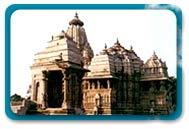 Jhansi - Lying at a distance of 292 Kms from Lucknow and about 415 Kms from Delhi. Jhansi is the gateway to Bundelkhand. The city is more popularly linked with the heroics of Rani Laxmi Bai, the fiery queen who fought against the Britishers in the 1857 revolt. Located on a rocky hill, the Jhansi fort was built originally in 1613 by Raja Bir Singh Ja Deo and has a marvelous collection of sculptures reflecting a excellent insight into the grand history of Bundelkhand. A fine collection of sculptures belonging to the period between 9th and 12th centuries A.D. has been housed in the Rani Mahal. Jhansi - Lying at a distance of 292 Kms from Lucknow and about 415 Kms from Delhi. Jhansi is the gateway to Bundelkhand. The city is more popularly linked with the heroics of Rani Laxmi Bai, the fiery queen who fought against the Britishers in the 1857 revolt. Located on a rocky hill, the Jhansi fort was built originally in 1613 by Raja Bir Singh Ja Deo and has a marvelous collection of sculptures reflecting a excellent insight into the grand history of Bundelkhand. A fine collection of sculptures belonging to the period between 9th and 12th centuries A.D. has been housed in the Rani Mahal.
Lucknow - Centuries down the line, Lucknow the capital city of Uttar Pradesh has been the hub of the business centers in Uttar Pradesh. Once the capital of the Awadhi kingdom, the city still continues to wear the princely statehood on its sleeves. The state boasts of its monuments, palaces, gardens, mango orchards and most of all its cuisines. The 'Boolbuliyan' or Bada Immambara of Lucknow has no comparison all over the world. Shami Kabab specialty of the city is enough to stimulate your saliva glands and you will not get tired eating it hundred times the other dishes of the awadhi cuisine will recall you to this city again and again. The high mannerism and the soothing melodious Urdu language of the city revitalize your soul. The political capital is the best city to start your tour from and don't forget to take the chikankari embroidery suit for yourself.
 Meerut - Meerut is one of the most important towns in the Northern part of India. The town, situated in Western Uttar Pradesh has got a long history behind it. The city was the part of Hastinapur Empire of Kaurvas that ruled the Vedic India and was the protagonists of Hindu Epic of Mahabharata. The city again rose to prominence in medieval times when it defended itself vehemently but unsuccessfully against Timor The Lame. Meerut - Meerut is one of the most important towns in the Northern part of India. The town, situated in Western Uttar Pradesh has got a long history behind it. The city was the part of Hastinapur Empire of Kaurvas that ruled the Vedic India and was the protagonists of Hindu Epic of Mahabharata. The city again rose to prominence in medieval times when it defended itself vehemently but unsuccessfully against Timor The Lame.
Moradabad - Moradabad is a city in Uttar Pradesh state of India. It was established in 1600 by Murad, the son of the Mughal Emperor Shahjahan; as a result the city came to known as Moradabad. It is the administrative headquarters of Moradabad District. Moradabad is situated at a distance of 167 km (104 miles) from the national capital, New Delhi, at the bank of River Ram Ganga (a tributary to the great Ganges). The city is famous for its huge export of brass handicrafts to North America and Europe, and is also thus called "Brass City" or Peetal Nagri (in the local language).It has close to four million citizens of various ethnicities and religions.
Saharanpur - Saharanpur is a famous but small city of Uttar Pradesh. It is famous for its wood carving all over the world and it got its name by the name of Sufi saint, 'Shah Harun Chisti' in 13th century. The climate here is similar to that of Uttar Pradesh; but its proximity to hills makes the difference here.
Saharanpur is famous for its sugar industry because of its large production of sugarcane. The other industries found in Saharanpur are its paper, paper-board and wood craft industry. The reason for these industries being popular in Saharanpur is the thick forests covering Saharanpur and the Shivalik range that provides the wood for the industries.
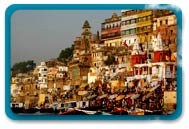 Varanasi - The whole world of Varanasi together with the lifestyle of the people revolve around the sacred waters of river Ganga, the ghats personating as a natural supplement to the concept of divinity. The spectacular 4 km sweep of the Ghats is a unique sight, best viewed at dawn, in the soft first light, when the river drenching the feet of these solitary stairs have a timeless appeal. Hire a boat from the most famous Dashashwamedha Ghat, and splurge on a unique tour that defines the true, yet spiritual heart of India. Near the Hanuman Ghat, one stumbles across Rani Lakshmibai's (the famed woman warrior who sacrificed her life during India's first war of Independence) place of birth. Across the Ganges is the Ramnagar Fort where one can admire the antique car collection of the Maharajah. This 17th century palace was the home of the Maharaja of Varanasi and has a temple and a museum within the grounds. Varanasi - The whole world of Varanasi together with the lifestyle of the people revolve around the sacred waters of river Ganga, the ghats personating as a natural supplement to the concept of divinity. The spectacular 4 km sweep of the Ghats is a unique sight, best viewed at dawn, in the soft first light, when the river drenching the feet of these solitary stairs have a timeless appeal. Hire a boat from the most famous Dashashwamedha Ghat, and splurge on a unique tour that defines the true, yet spiritual heart of India. Near the Hanuman Ghat, one stumbles across Rani Lakshmibai's (the famed woman warrior who sacrificed her life during India's first war of Independence) place of birth. Across the Ganges is the Ramnagar Fort where one can admire the antique car collection of the Maharajah. This 17th century palace was the home of the Maharaja of Varanasi and has a temple and a museum within the grounds.
 Places to Visit Places to Visit
 Taj Mahal - Epitome of Love :
An undying symbol of love that has braved the tests of time, Taj Mahal at Agra is truly the epitome of beauty, elegance and wonder rolled into one. Regarded as the seventh wonder of the world, the Taj Mahal has been highly successful in placing India on the world tourism map and get undisputed importance and fame. Built over a time period of 22 years by the Mughal emperor Shah Jahan in the memory of his beloved wife Mumtaz Mahal, the Taj Mahal till date never fails to attract love struck couples from far and wide. Taj Mahal - Epitome of Love :
An undying symbol of love that has braved the tests of time, Taj Mahal at Agra is truly the epitome of beauty, elegance and wonder rolled into one. Regarded as the seventh wonder of the world, the Taj Mahal has been highly successful in placing India on the world tourism map and get undisputed importance and fame. Built over a time period of 22 years by the Mughal emperor Shah Jahan in the memory of his beloved wife Mumtaz Mahal, the Taj Mahal till date never fails to attract love struck couples from far and wide.
The Taj Mahal is considered to be the symbol of undying love. It is supposed to be a timeless beauty that depicts the splendor of a woman who truly loved her husband. The Taj Mahal continues to enthrall not just visitors but also artists, painters, sculptors, poets and photographers. Never has a monument been talked of so much that it appears in each and every aspect of art. The exquisite monument in white marble stands on the banks of the River Yamuna in Agra and looks picture perfect. It gives the word "perfection" an entirely new meaning.
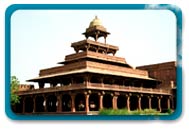 Fatehpur Sikri :
Situated 40 kms south-west of City of Taj - Agra, Fatehpur Sikri is a perfectly preserved Mughal city that you should not miss during your Agra trip. The name 'Sikri' originates from the Urdu word 'Shukriya', meaning thanks to Allah (God) and was originally uttered by Mughal Emperor Babar on the occasion of his triumphs over the Rajputs. But, today everything else related to Babar has vanished in Fatehpur Sikri except the place name 'Sikri'. Fatehpur Sikri :
Situated 40 kms south-west of City of Taj - Agra, Fatehpur Sikri is a perfectly preserved Mughal city that you should not miss during your Agra trip. The name 'Sikri' originates from the Urdu word 'Shukriya', meaning thanks to Allah (God) and was originally uttered by Mughal Emperor Babar on the occasion of his triumphs over the Rajputs. But, today everything else related to Babar has vanished in Fatehpur Sikri except the place name 'Sikri'.
When Emperor Akbar conquered Gujarat, he expanded the name by adding Fatehpur to Sikri and since then 'Sikri' became known as Fatehpur Sikri. Akbar established the town of Fatehpur Sikri to commemorate his Gujarat victory and even made this city his new capital that remained operational between 1570 and 1586. But extreme scarcity of water forced Akbar to reshift his capital to Agra from Fatehpur Sikri and the city was abandoned.
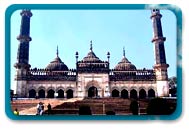 Bada Imambara :
The Bada Imambada is an important tourist attraction of Lucknow. It was built by the erstwhile Nawab of Lucknow to provide succor to the famine stricken people. Though it began as a charitable project, yet the largeThe Bada Imambada is an interesting building. It is neither a mosque, nor a mausoleum, but a huge building having interesting elements within it. The construction of the halls and the use of vaults show a strong Islamic influence.
halls, vaulted galleries, and an intriguing labyrinth of interconnected passages within it make it an amazing edifice.
Bada Imambara :
The Bada Imambada is an important tourist attraction of Lucknow. It was built by the erstwhile Nawab of Lucknow to provide succor to the famine stricken people. Though it began as a charitable project, yet the largeThe Bada Imambada is an interesting building. It is neither a mosque, nor a mausoleum, but a huge building having interesting elements within it. The construction of the halls and the use of vaults show a strong Islamic influence.
halls, vaulted galleries, and an intriguing labyrinth of interconnected passages within it make it an amazing edifice.
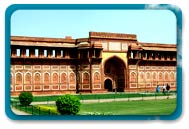 Jehangir Palace :
Of course, tourists visit Agra for marvellous Taj Mahal and massive Agra Fort, but in addition to these, there is a monument called - Jehangir Palace, which deserves to be visited during your Agra trip. So, when you are on Agra tour and are exploring the hidden corridors and palaces of Agra Fort, don't forget to see the magnificent Jehangir Palace.
Believed to be built by Emperor Akbar for his son Jehangir, Jehangir Palace is the largest private residence in Agra fort. After Akbar's death, Jehangir occupied the throne, eventually the Palace became his residence. Jehangir Palace was one of the first constructions within the Agra Fort where the focus started to shift from purely military to the fort's later function as a luxurious palace.
Jehangir Palace :
Of course, tourists visit Agra for marvellous Taj Mahal and massive Agra Fort, but in addition to these, there is a monument called - Jehangir Palace, which deserves to be visited during your Agra trip. So, when you are on Agra tour and are exploring the hidden corridors and palaces of Agra Fort, don't forget to see the magnificent Jehangir Palace.
Believed to be built by Emperor Akbar for his son Jehangir, Jehangir Palace is the largest private residence in Agra fort. After Akbar's death, Jehangir occupied the throne, eventually the Palace became his residence. Jehangir Palace was one of the first constructions within the Agra Fort where the focus started to shift from purely military to the fort's later function as a luxurious palace.
 Agra Fort :
The fort's colossal double walls rise 20 meters in height and measure 2.5 kilometers in circumference. Typical of forts of Mogul era, Agra Fort is surrounded by a moat. The fort looks intimidating because of its lofty battlements that overlook the far stretching mansions of nobles and princes built along the riverfront. Another important and very significant structure is the dominating gateway that is surrounded by the magnificent towers, bastions and ramparts. The fort contains some of the most magnificent and subtle palaces both in red sandstone and white marble that has been built by two generations of prolific builders; Akbar and later on by Jahangir and Shah Jahan.
Agra Fort is among the finest examples of the fusion architecture that has dominated the Mogul period. The assimilation of these different styles has given the buildings within the fort a distinctive look. To name a few, for example, the Jahangir Palace built by Akbar is the most magnificent blend of Persian and local style where as Divan-e-Aam mixes subtleness of Turkish exteriors with the complex pattern of Persian architecture. Other buildings within the premises of Agra Fort either have a mixed style or conform predominantly to the Islamic style. Some of the important buildings inside the Agra Fort include Jahangir Mahal, Divan-e-Aam, Divan-e-Khash, Khas Mahal, Anguri Bagh, Musamman Burj, Moti Masjid, Mina Masjid and Shish Mahal among others.
Agra Fort :
The fort's colossal double walls rise 20 meters in height and measure 2.5 kilometers in circumference. Typical of forts of Mogul era, Agra Fort is surrounded by a moat. The fort looks intimidating because of its lofty battlements that overlook the far stretching mansions of nobles and princes built along the riverfront. Another important and very significant structure is the dominating gateway that is surrounded by the magnificent towers, bastions and ramparts. The fort contains some of the most magnificent and subtle palaces both in red sandstone and white marble that has been built by two generations of prolific builders; Akbar and later on by Jahangir and Shah Jahan.
Agra Fort is among the finest examples of the fusion architecture that has dominated the Mogul period. The assimilation of these different styles has given the buildings within the fort a distinctive look. To name a few, for example, the Jahangir Palace built by Akbar is the most magnificent blend of Persian and local style where as Divan-e-Aam mixes subtleness of Turkish exteriors with the complex pattern of Persian architecture. Other buildings within the premises of Agra Fort either have a mixed style or conform predominantly to the Islamic style. Some of the important buildings inside the Agra Fort include Jahangir Mahal, Divan-e-Aam, Divan-e-Khash, Khas Mahal, Anguri Bagh, Musamman Burj, Moti Masjid, Mina Masjid and Shish Mahal among others.
 People & Life Style People & Life Style
'Uttar Pradesh is the holy land of the holy People',over the years the people of the state has proved the saying by their sober nature, royal mannerism and the high literal taste. The city of Nawabs has thousands of stories about their etiquettes which has influenced the whole state. The calmness of the people and their display of affection for the younger and respect for the elders is a trait to be followed by one and all. The moral sense of the inhabitants is worth laurels. Constituting the majority of the Hindu population, Uttar Pradesh is a state where the people of all communities live like the single soul in complete harmony. The literal taste of the state has given birth to thousands of scholars and philosophers, writers and poets, dancers and musicians, politicians and academicians. With the eight Prime ministers from the state the people have never boasted about their achievements. The simplicity and down -to-earth nature of the natives is calling. A visit to Uttar Pradesh is worth to experience the elegance of the people.
 Cuisine Cuisine
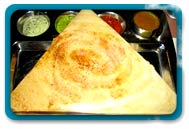 Uttar Pradesh is divided politically, geographically and by cuisines in to 3 distinct zones namely Western UP, Oudh and Eastern Utter Pradesh. The most illustrious region among these in terms of culture and cuisine is Oudh or Awadh as it is called sometimes. The Oudh region offers a range of option in terms of cuisines. Uttar Pradesh is divided politically, geographically and by cuisines in to 3 distinct zones namely Western UP, Oudh and Eastern Utter Pradesh. The most illustrious region among these in terms of culture and cuisine is Oudh or Awadh as it is called sometimes. The Oudh region offers a range of option in terms of cuisines.
The most famous cuisines in Oudh are Kabobs, Biryani and Nihari. Due to Muslim dominance and influence on the culture and cuisine of this region, you will find that most of the items are meat based. Among the kabobs Shami and Galawati kabobs are the specialty of Lucknow and so are Kulcha-Nihari and Biryani. It should be kept in mind that the Biryani that is cooked in Oudh is quite different from its cousins of Hyderabad and Karachi in Pakistan. The Kanpur region brings Kakori and Boti kabobs. The most famous vegetarian dishes of this region are Tahri and Nargishi kofta. While the former is cooked with rice and lentils, the later has a generous dose of cheese, Khoya and saffron.
In the western Uttar Pradesh or Rampur region, the major delicacies are Rampuri Rohu and Zamindoz; both items of fish. It is quite interesting to know that these regions are hardly 200 kilometers apart but there is quite remarkable difference in the spices and hence tastes of dishes. The kabobs that are famous in Rampur region are Pasanda Kabob and Shab Deg. The most famous vegetarian dish of this region is Paneer Pasanda.
In the eastern Uttar Pradesh Tahri and Reshmi kabobs are very famous. Besides, Murg Musallam is another favorite dish of this region. Among the sweets, Mathura and Agra zone has clearly an edge. The Khurchan and Peda are some of the favored sweet items in Mathura region. Petha in nearby Agra is very popular all over India. The Shahi Tukda of Oudh region is very popular too. Among the drinks Lassi and Ruh-afza are the most favored one in Uttar Pradesh. No talk on cuisines can be rounded off without mentioning Paan of Benaras. Banarsi Paan is famous all over India for its taste and ingredients, which at times touch 50 in counts. |
| Back |
|
|
|
|
|
|
|
|
|
|
|
|
|
|
